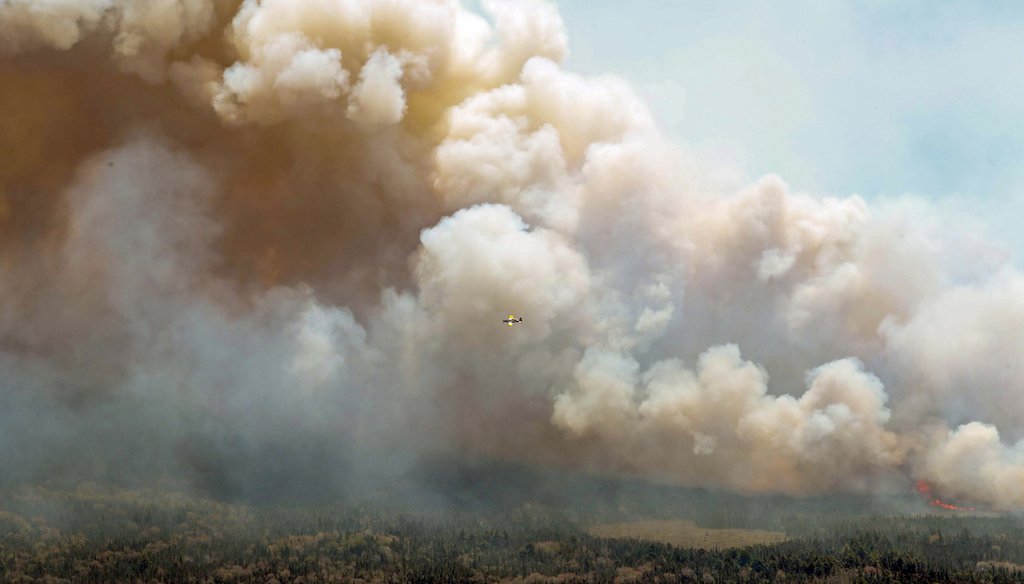Get PolitiFact in your inbox.

In this aerial image, an aircraft, center, flies near a wildfire burning near Barrington Lake in Shelburne County, Nova Scotia, on Wednesday, May 31, 2023. (AP)
If Your Time is short
-
Climatologists and wildfire experts agree that human-caused climate change is worsening wildfires.
-
Hotter, drier and windier weather can make it easier for wildfires to start and continue burning. And higher temperatures can reduce moisture available for trees and plants, making them fuel for fires.
-
Studies have also shown that rising temperatures have extended the length of the season in which wildfires are typically the most frequent and severe.
With Canada facing one of its worst wildfire seasons in history and smoke from the fires blanketing parts of the United States, some have questioned the notion that climate change is to blame.
But climatologists and wildfire experts say there is no question about the link, which is supported by years of research. Extensive research has analyzed human-caused climate change’s effect on wildfires, and the consensus is that climate change is making wildfires more frequent, severe and long-lasting.
Canada is no stranger to wildfires, but this year’s activity has been unusually destructive, experts say. As of June 8, the U.S.’ northern neighbor had 431 active fires burning, 235 of them considered to be out of control, according to the Canadian Interagency Forest Fire Centre. Most of the active fires are in the province of Quebec.
The wildfires have burned more than 9 million acres in Canada so far this year, which is nearly 12 times the 10-year average, the Canadian government reported. At least 20,000 people in Canada have been displaced, and millions more in Canada and the U.S. have been affected by smoke polluting the air.
Still, some people have questioned or denied climate change’s role in this disaster.
But numerous studies have found climate change is exacerbating wildfires, which leads to increased environmental and property damage.
Warmer weather heightens the risk of wildfires
Wildfires usually start because of lightning strikes or human activity, such as a person dropping a burning cigarette. And if the weather is hot, dry and windy — conditions brought about by climate change — it is more likely that a fire will start and intensify.
Hotter weather also brings more lightning strikes, which increases the risk of fires. A 2018 study conducted by researchers in Canada found that fires caused by lightning strikes have been increasing, while human-caused fires have declined.
Before the recent wildfires in Quebec, there were thunderstorms across the region, Instant Weather Ontario reported. In many of the places where lightning struck, a wildfire was ignited, and then strong winds stoked them into a massive blaze.
The provinces of Alberta, Nova Scotia and Quebec have reported record high temperatures this year. Canada’s Atlantic region has also been experiencing droughts since February.
Almost every region in the world is facing more intense and frequent hot weather, which has heightened the risk of fires, said Matthew Kasoar, a research associate in earth system modeling at Imperial College London’s Leverhulme Centre for Wildfires, Environment and Society.
"We are seeing this play out in North America both with the current excess of fires in Canada, as well as in other exceptionally intense fires that have occurred across the continent just in the last few years," Kasoar said.
Fueling the fire
Climate change is not only making summers warmer, but also winters.
Higher winter temperatures reduce snow accumulation, referred to as "snowpack," meaning trees and plants receive less water later as snow melts. This leads to drier trees and plants, which in turn fuel wildfires.
Reduced snowpack and faster snow melts mean more intense and longer-lasting fires the following summer, Kelly Gleason, a Portland State University snow hydrologist and assistant professor, said in NASA’s 2019 report on wildfires.
"It creates this vicious cycle where snow melts earlier due to climate change, which extends the summer drought period where the soil dries out, and when the fuels dry out, you get these big fires. This further accelerates snowmelt, further extending the summer drought period and fire potential," Gleason said.
Wildfire season is getting longer and more extreme
Although wildfires can occur any time of the year, they most often happen in late spring and summer, when the weather is warmer and drier. But as the planet warms year-round due to climate change, wildfire season has become lengthier and more intense.
A 2023 report by the Organization for Economic Cooperation and Development found that the length of fire weather season has increased by 27% globally since 1979. In Australia, the frequency of wildfires has doubled since 1980. And in the western U.S., wildfire severity, or the degree of ecosystem impacts caused by a fire, was eight times higher in 2017 than it was in 1985, according to the report.
Climate change is a "key driver" behind the increasing frequency and severity of wildfires, the report said.
Another study, published in 2016 by University of Idaho and Columbia University professors, also found evidence of human-caused climate change exacerbating forest fire activity in the U.S.
Researchers found that from 1984 to 2015, climate change caused increases in warmer, drier weather that turned trees into tinder. This led to forest fires burning an additional 4.2 million hectares, or more than 10.3 million acres, of land. This is nearly double the amount of land that was expected to be affected by forest fires from natural climate variability alone.
The European Commission’s Joint Research Centre also said in its 2021 annual report that there was "clear evidence" the effects of climate change had resulted in not only the expansion of the areas affected by wildfires, but the longer duration of the fire season.
"Heat waves and wildfire risk will continue to become more intense and more frequent as long as the world burns fossil fuels," said Kasoar, of Imperial College London. "As we’re seeing with the current fires in Canada, smoke pollution can also travel long distances and doesn’t respect country borders — highlighting that no one is immune from the impacts of climate change."
RELATED: No evidence wildfires in Canada were set intentionally
Our Sources
Email interview, Matthew Kasoar, research associate in earth system modeling at Imperial College London’s Leverhulme Centre for Wildfires, Environment and Society, June 9, 2023
Email interview, Kevin Reed, associate dean for research and associate professor at Stony Brook University’s School of Marine and Atmospheric Sciences, June 8, 2023
European Commission’s Joint Research Centre, "Forest Fires in Europe, Middle East and North Africa 2021," November 2022
Earth’s Future, "Attribution of the Influence of Human‐Induced Climate Change on an Extreme Fire Season," January 2019
SpringerLink, "Attributing extreme fire risk in Western Canada to human emissions," July 15, 2017
Canadian Science Publishing, "Fire-regime changes in Canada over the last half century," Nov. 16, 2018
John T. Abatzogloua and A. Park Williams, "Impact of anthropogenic climate change wildfire across western US forests," Oct. 18, 2016
NASA, "A drier future sets the stage for more wildfires," July 9, 2019
Instant Weather Ontario, tweet, June 8, 2023
Tweet, June 8, 2023
NASA Earth Observatory, "Raging Fires in Nova Scotia," May 29, 2023
Government of Canada, "Canadian Wildland Fire Information System | Current graphs," accessed June 9, 2023
Canadian Interagency Forest Fire Centre, "Interactive Map," June 8, 2023
British Columbia, "What causes wildfires," accessed June 8, 2023
The Associated Press, "Millions breathing hazardous air as smoke from Canadian wildfires streams south over US," June 8, 2023
The Washington Post, "What to know about the Canadian wildfires causing poor air quality in the U.S.," June 7, 2023
Organization for Economic Cooperation and Development, "Taming Wildfires in the Context of Climate Change," May 17, 2023
Climate Signals, "Wildfires," accessed June 9, 2023
Climate Signals, "Climate Change & Wildfires," accessed June 9, 2023
Intergovernmental Panel on Climate Change, "Human-caused climate change impacts severe, widespread," Aug. 9, 2021
Science, "Projected increase in lightning strikes in the United States due to global warming," Nov. 14, 2014
PolitiFact, "No evidence wildfires in Canada were set intentionally," June 8, 2023
PolitiFact, "No, wildfires weren’t bigger in the 1920s and ’30s than today," Oct. 15, 2021
PolitiFact, "Climate change created conditions for the West Coast fires, experts say," Sept. 15, 2020




























